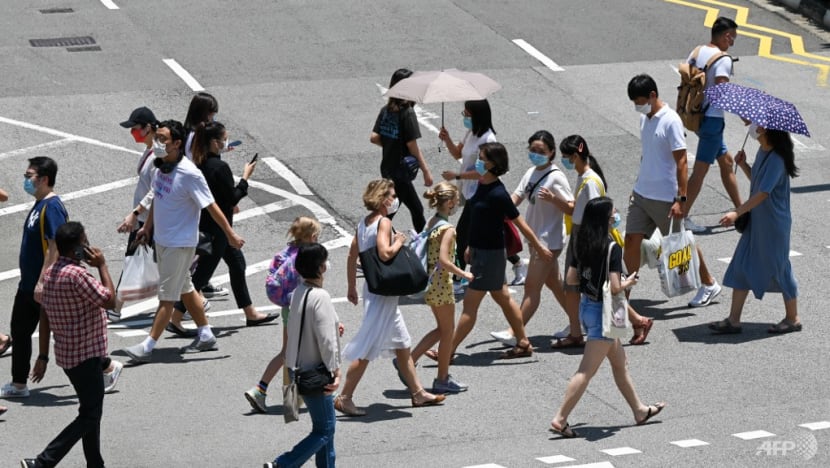Singapore’s resident employment rate above pre-pandemic levels, but labour market still impacted by COVID-19: MOM
Incomes of residents also went up in 2021.

People walk at a pedestrian crossing along Orchard Road in Singapore on Sep 7, 2021. (File photo: AFP/Roslan Rahman)
SINGAPORE: Singapore’s resident employment rate has risen above pre-pandemic levels, however, unemployment rates continue to remain elevated, the Ministry of Manpower (MOM) said in the advance release of its annual Labour Force in Singapore 2021 report on Wednesday (Dec 1).
“The resident employment rate rose above pre-COVID levels, bolstered by tripartite efforts under the SGUnited Jobs and Skills Package,” MOM said.
“While demand for temporary manpower arising from COVID-related activities contributed to higher employment, the number of residents in permanent jobs also grew.”
Unemployment and time-related under-employment rates have improved, but are still above where they were before the pandemic, the ministry added.
Nominal and real incomes for residents have both risen, with the median income surpassing its pre-pandemic level as a result. While real income growth was moderated by higher inflation, it exceeded the slight decline seen in 2020.
“The labour market gradually recovered in 2021, although it has not fully returned to pre-COVID conditions,” MOM said.
“We expect the labour market recovery to continue in the second half of the year and into 2022, but in an uneven manner across sectors.”
EMPLOYMENT RATES UP ACROSS DEMOGRAPHICS
The employment rate for residents aged 15 and over as of June 2021 was 67.2 per cent, up from 64.5 per cent last June and also above the 65.2 per cent reported in June 2019.
“This reflected economic recovery and the impact of measures such as the SGUnited Jobs and Skills Package, Jobs Support Scheme and Jobs Growth Incentive on the labour market,” MOM said.
More than 146,000 people had been placed into jobs or attachment and training opportunities under the SGUnited Jobs and Skills Package as of the end of September this year.
The Jobs Growth Incentive scheme, which supports employers in expanding local hiring, helped 58,000 businesses hire more than 400,000 locals between September 2020 and May 2021.
Employment rates were up across demographic profiles.
The employment rate for youths aged 15 to 24 stood at 37.2 per cent in June, compared to 30.9 per cent a year earlier, with “more students taking on part-time or temporary work" on the side, MOM said.
For residents aged between 25 and 64, the employment rate was at 81.8 per cent, ahead of the 80.3 per cent reported in 2020. Men in this age group saw a rise from 87.9 per cent to 88.9 per cent, while the rate for women went up to 75.1 per cent from 73.2 per cent.
“Supported by sustained efforts to raise the employability of seniors, such as the Senior Worker Early Adopter Grant, the employment rate of seniors aged 65 and over rose to 28.5 per cent in June last year despite the recession, and continued to increase at a faster pace to 31.7 per cent as at June 2021,” MOM said.
Among resident employees, 88 per cent were in permanent positions, with the number of such employees growing by 50,900.
The percentage of employees on fixed-term contracts hit a new high of 8.4 per cent due to economic uncertainty and the demand for temporary manpower related to the pandemic. Last June, this number was 7.3 per cent.
Related:
UNEMPLOYMENT RATES DOWN, BUT STILL ELEVATED
Non-seasonally adjusted unemployment rates were down for both professionals, managers, executives and technicians (PMETs) and non-PMETs in June, however they have not yet dropped to pre-pandemic levels.
The unemployment rate among non-PMETs stood at 5.1 per cent, down from 6.4 per cent a year earlier. Among PMETs, the rate was 3.4 per cent, a slight dip from the 3.5 per cent reported in June 2020.
“The resident long-term unemployment rates held steady at 0.8 per cent for PMETs and 0.9 per cent for non-PMETs after increasing last year,” MOM said.
“The elevated long-term unemployment rate compared to pre-COVID suggests that some workers who were displaced earlier faced challenges in their job search.”
Time-related under-employment rate was also down this year, dropping to 3.5 per cent from the 4.1 per cent seen last June. This rate also remains above its pre-pandemic level.
Time-related under-employment accounts for part-time workers aged 15 and older who normally work less than 35 hours a week but are willing and available to engage in additional work.
“Most groups experienced improvements, including lower-educated and older workers who were more affected last year,” MOM said.
“Affected by the suspension of dine-in services and in-person tuition/enrichment classes during the Heightened Alert period, time-related under-employment rates were highest in food and beverage services and education in June 2021, and their rates were also higher than pre-COVID levels.”
MEDIAN INCOMES UP
The nominal median income of full-time employed residents was up 3.2 per cent in June, compared to last year’s 0.6 per cent decline. This includes employer Central Provident Fund (CPF) contributions.
Real median income growth was a more modest 1.1 per cent after accounting for inflation, however, it offset the 0.4 per cent decline seen in 2020.
Real income of full-timers at the 20th percentile was up 4.6 per cent, recovering to around its pre-pandemic level, MOM said.
After including Workfare Income Supplement-related payouts from the Government, 20th percentile income was 0.6 per cent per annum above its pre-pandemic level, based on preliminary data.
“Over a five-year period (2016 to 2021), the real income growth of lower-wage workers remained strong, enabling them to continue to gain ground on median incomes,” MOM said.
“Supported by efforts such as the Progressive Wage Model to uplift lower-wage workers, real income growth at the 20th percentile (2.8 per cent per annum) of full-time employed residents was higher than the median income growth (2.2 per cent per annum).”
MOM said that both employers and employees will continue to be supported as Singapore’s recovery from the pandemic carries on.
“The Government and tripartite partners will continue to support employers and workers to emerge stronger from COVID-19 through the SGUnited Jobs and Skills Package,” MOM said.
“With the pace of transformation accelerated by COVID-19, our focus is on preserving human capital and developing local workers through skills upgrading to prepare for jobs of the future.
“At the same time, we will continue to work with employers to improve job quality through job redesign.”
The Labour Force in Singapore Advance Release 2021 report used field work from the mid-year Comprehensive Labour Force Survey and analysed a broad range of labour market indicators including employment rate and income growth. This data is not covered in MOM’s quarterly labour market reports.
A total of 26,637 households responded to this year’s survey, with field work taking place from May 18 to Jul 31.
























